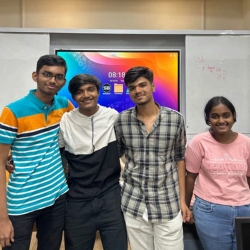Phillip Colella is a mathematician who has been a staff member and leader of the Applied Numerical Algorithms Group at the National Energy Research Scientific Computing Center (NERSC) and the Computing Sciences Directorate at Lawrence Berkeley National Laboratory since 1996. He earned his bachelor’s, master’s and doctorate degrees in math at UC Berkeley.
Colella combines the field of math and computing in the development of algorithms aimed at better understanding such complex problems as fluid dynamics. Colella’s group is creating more accurate computer models of the diesel combustion process with the goal of increasing fuel efficiency and reducing emissions. The interior of an internal combustion engine is a hot, dirty environment for conducting experiments. Making smalls changes in the valves, cylinder head or piston to try to influence the combustion process can be expensive and time consuming.
Computer models, such as those being developed by Colellas’s group, can give researchers a virtual look into the complicated process of fuel and air intake, combustion and exhaust. Currently, combustion models can’t entirely predict the combustion within an engine, but they are getting closer. Progress is made by breaking the problem down into smaller pieces, or sub-problems, a tacking individually.
Colella’s group is working with two of the nation’s leading vehicle manufacturers to develop more accurate models of combustion processes. These models will require even greater computing resources, such as the 640-processor Cray T3E-900 supercomputer housed in NERSC at Berkeley Lab. Those models are then compared with experimental data, matching predictions with actual results. “Applying more computing power will allow us to incorporate more details and create better models,” Colella says. “You can’t just throw bigger computers at the existing models, though. You have to create better models.”
There are four areas in high-performance computing to which Colella has made a substantial contribution. The first is in high-resolution finite difference methods. Colella has been a major innovator in the development of such methods for a broad range of problems. These include higher-order Godunov methods for hyperbolic conservation laws as they arise in a variety of applications, such as compressible flow no convex and nonstrictly hyperbolic systems, MHD elastic plastic flow and porous media problems. In addition, Colella has combined the higher order Godunov methods for hyperbolic problems with predictor corrector methods to develop projection methods for incompressible and low Mach number reacting flows.
Colella has made substantial contributions in the area of adaptive mesh refinement (AMR) for finite difference methods. In his work with Berger they developed a version for the BergerOliger AMR algorithm for unsteady shocks, and demonstrated that the method could be implemented without significant memory or CPU overheads on vector super computers. In addition, he coupled this method to a variety of other techniques for treating sharp fronts and irregular boundaries, as well as extending the method to incompressible flow radioactive heat transfer; and vortex methods.
An outgrowth of this work on AMR has been the investigation of new programming paradigms for scientific computation, beginning with the FIDIL programming language design of Hilfinger and Colella. In his work, they developed a set of fundamental abstractions for block structured grid methods and particle methods. This work has been the basis of a variety of C++ libraries for supporting high performance scientific computations developed at the DOE Labs (LBNL’s BoxLib, LLNL’s SAMRAI), as well as libraries for supporting grid based parallelism (Baden’s LPARX and KeLP packages). Colella is continuing this work in this participation in the Titanium language project, in which a dialect of Java is being developed for parallel scientific computation.
Colella has made great contributions in the volume of fluid methods for fronts and irregular geometries. He has developed a variety of innovative algorithms for coupling volume of fluid representations of sharp fronts to conservative finite difference methods. In his work on front tracking for conservation laws, he developed an explicit, conservative method for coupling a volume of fluid representation of a front to a conservative finite difference solver for hyperbolic conservation laws. A key idea in this method is a solution of the “small cell” stability problem caused by explicit differencing in arbitrarily small control volumes. This problem is solved by redistributing the flux differences in the small cells, which eliminates the instability while maintaining discrete conservation form.
Colella has applied that algorithm to obtain a Cartesian grid treatment of irregular boundaries for unsteady viscid compressible flow in three dimensions. In both of these applications, he coupled these methods to the AMR algorithm discussed above. More recently, he has developed a formally consistent and well conditioned algorithm for solving elliptic PDE’s on irregular domains using a Cartesian grid volume of fluid representation of the irregular boundary.
In a series of papers, Colella and his collaborators have applied various combinations of the algorithms described above, using high performance computing to substantially expand our understanding of time dependent multidimensional shock dynamics. They demonstrated the ability to obtain quantitative agreement with experimental data and showed that transition amongst the various reflection patterns could be largely described by self similar analysis, with the principal discrepancies explained by non-ideal effects (mainly finite relaxation times to equilibrium in gases, and, to a lesser extent, boundary layer questions regarding weak shock reflection, characterizing a new form of shock reflection and the transition criteria between it and the classical cases.
This work was done with an elaborate combination of the algorithm technologies described above: a higher order Godunov method for the gas dynamics; volume of fluid method for representing the interface between the two gases; and adaptive mesh refinement. Again, they were able to demonstrate excellent agreement with experimental data, and delineate the relationship between self similar shock theory and the observed transitions between the various wave refraction patterns. The method developed for this investigation was also used to study the question of how the interstellar medium is affected by the passage of a supernova shock wave.
Colella predicts the next generation of simulation and modeling technology will arrive within five years. He says, “Such models will allow engineers to explore many different design options at much less expense.”










